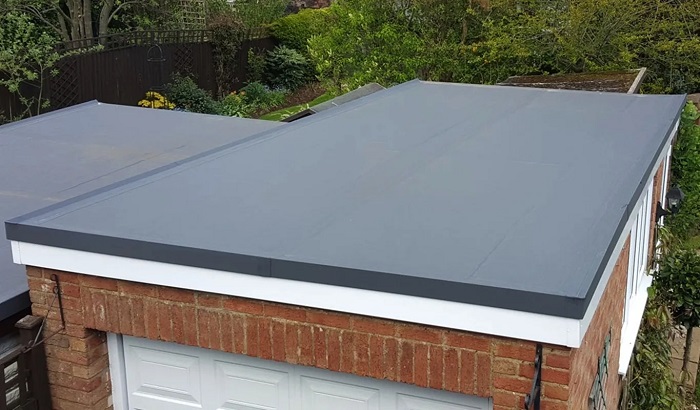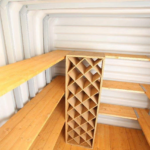Lately, the flat roofing for flat surface systems have gained popularity in residential and commercial buildings because of their contemporary nature, use of space effectively and also the low cost at which they are installed.
Although the roofing for flat top structure may portray the idea of a simple overhead structure, it takes proper planning, quality materials like bituminous roofing, and accuracy in craftsmanship to make the overhead structure achieve the desired durability and long life performances. The distinction between a basic installation and an outstanding one in a challenging climate zone like Northern Europe could be decades of extra service and much less maintenance expenses.
This paper discusses the key steps to excellence in the installation of roofing for flat roofs, including the choice of the material, the installation process, waterproofing and drainage systems, and conservative measures. As a property owner, an architect, or a contractor, it is only with knowledge of such best practices and right suppliers such as a roofing materials store that your investment is guaranteed to deliver the desired performance even in the future.
The Importance of Material Selection
The quality of materials chosen is the basis of the durable covering. In the case of flat buildings, where moisture, UV radiation and thermal movement are able to affect the material more readily than on a sloping surface, the material used will have to resist the constant exposure to water, UV radiation and movement of heat. EPDM (Ethylene Propylene Diene Monomer) is one of the most widespread materials that can be mentioned due to its elasticity and ability to withstand UV degradation. It is a single-ply membrane that is easy to install, lightweight, and with enough care, it shows a life span of 25-30 years hence it has been the favorite of several contemporary constructions.
TPO (Thermoplastic Polyolefin) is highly reflective and energy-efficient and in this regard, it is desirable in environmentally sensitive structures; its welded seams form extremely strong junctions that enhance waterproofing. PVC (Polyvinyl Chloride) however, is very resilient, inflammable and does not degrade when exposed to chemicals and as such is very applicable in those commercial buildings that are located in the tougher climates. Finally, bituminous top structure is also a reliable and proven product, but it involves a mixture of asphalt and bituminous materials to make it more flexible and durable with the help of a multi-layer compound, yet it typically goes through the courses of a professional. The top structure insulation price in these systems varies depending on the type of insulation used and the complexity of design. Homeowners can compare offers from a roofing materials store to get a clear picture of how insulation price influences the long-term performance of the system. Contractors often rely on turnkey roofing solutions with bituminous membranes, as they combine strength with durability.
Proper Installation Techniques
Even the finest materials may break down at a very early stage in case they are installed in the wrong manner. Roofing for flat top structures requires accuracy in the water.. The covering iinsulation price becomes meaningless if poorly installed.
Important phases of installation are:
- Surface treatment: The surface should be clean, smooth and without any sharp debris which may puncture the membrane. Rough edges cause weak spots in the system.
- Vapor barriers: In cold climates, under the insulation, the use of a vapor barrier prevents the destruction of the top structure by condensation.
- Placement of insulation: Rigid insulation boards must be well staggered and fitted to prevent any thermal bridging and movement. The top structure insulation price is justified only if installed properly.
- Application to membranes: The membrane whether EPDM, TPO, PVC, or bituminous roofing should be applied as per manufacturer instructions with attention paid to seams, penetration and edges. The membrane can be adhered, mechanically fixed or ballasted.
- Edge finishes: Fixed site information is vitally important in wind resistance and preventing moisture entry.
- The talented contractors are making sure that every step will be done to industry standards and will not have shortcuts which might affect the long term performance of the roofing for flat surface.
Waterproofing Methods
Waterproofing is said to be the most crucial aspect of roofing for flat top structures. The fact that water collects on such surfaces means that any failure on seams or holes can easily lead to a leakage.
Best practices include:
- Seam reinforcement: Hot-air welding, glued bonding or welded seams should be checked to ensure that they are watertight.
- Flashing installation: This is done by the installation of areas surrounding chimneys, vents and skylights which should be flashed with the compatible bituminous materials to avoid leaking.
- Protective Coatings: Reflective or Elastomeric coatings can be used to increase the life of membranes, and also enhance UV resistance.
- Two-layer systems: With bituminous roofing, two layers of membrane are used to enhance the durability and also offer redundancy.
Contractors can easily increase the life of a roofing for a flat surface system by incorporating the use of high quality membranes and effective methods of waterproofing.
Drainage Systems for Flat Roofing
One of the most popular myths is that flat surface are absolutely flat. As a matter of fact, a very small slope of 1-2% is required in order to make water move towards drainage points.
The drainage plans can be effective and they include:
Internal drains: This gathers water using strategically designed points which are attached to internal water piping. Although they are efficient, they need frequent cleaning to avoid being clogged.
- Scuppers: The parapet walls can have openings that can then ensure that water moves efficiently off the surface, typically into downspouts.
- Gutters: Their design should take into account snowmelt and heavy rain. The roofing felt cost and surface insulation price can be affected by gutter integration.
- Tapered insulation: A common solution, often supplied by a roofingmaterials store.
Maintenance Protocols
The standard flat surface can be converted to a long lasting and reliable system through regular maintenance. It is much cheaper to prevent than to repair or replace in case of major repairs.
It is advisable to practice the following points:
Bi-annual inspections: Inspections are ideally done during spring and autumn, and they assist in detecting the problems of membrane puncture, loose flashings, or blocked drains.
Snow and debris removal: The collected snow provides additional weight, and all the leaves and rubbish bar the drains. Take proper equipment not to destroy the surface.
Checks of sealants: Caulking and sealants at penetrations wear out with time, and are to be renewed as necessary.
Documentation: Helps track warranty terms from roofing materials store purchases and turnkey roofing installations.
Those who engage in the proactive maintenance program ensures that the investment in insulation price and roofing felt cost pays off.
Common Failure Points
The knowledge of general areas of breakdown enables the contractors and owners to be keen to the weak areas.
- Seams: Welds or adhesions: The most common sources of leaks are poorly welded or adhered seams.
- Flashing Information: improper installation around vertical penetrations causes water to seep into it.
- Drainage systems: Obstructed drains increase stress, negating the roof insulation price benefit.
- Membrane punctures: Puncture of membranes can be done by foot traffic, fallen tools, or sharp objects.
- UV degradation UV wears out in the presence of long sun exposure without coats.
- This will solve these problems at an early stage before it causes extensive destruction that will undermine the whole structure.
Industry Best Practices
Skills in flat roofing are required not only in the materials and techniques but also on the best practices required by the industry.
- Training and certification: Membrane manufacturers should also train installers to check system compliances with system warranties.
- Quality control: Workmanship is checked by supervising the work on the spot and after installation.
- Code compliance: This ensures that it is built to local building code standards which ensure that it is structurally and structurally safe.
- Sustainability: Reflective surfaces and energy efficient insulation will lead to lower energy usage and lower lifetime costs.
- The combination of these practices comes with high-quality outcomes that withstand time in the hands of the contractors.
Regional Climate Considerations
Plans of flat roofing depend on the climatic conditions of the location.
- Cold weather: Vapor barrier and insulation is of most importance to avoid the formation of condensation and the ice dam.
- Hot climates: Reflective surfaces help in lowering cooling expenses and hindering the degradation of membranes.
- Heavy rain areas: Improved drainage and strong waterproofing helps to avoid delays in being exposed to water.
- Areas that are prone to the wind: There is need for wind resistant perimeter terminations and mechanical fastening systems.
- Regionalization of the design is a relevant measure that would make optimally serve its term.
Cost Considerations and Value
Although flat surfaces might be low-cost to put in place, corner cutting may increase the overall costs in the long run. A system that is well installed and has a long lifespan minimizes the expenses of repair and replacement.
Cost factors include:
- Material type: EPDM, PVC, or bituminous roofing.
- Insulation levels: The higher the roof insulation price, the better the performance.
- Drainage complexity: Adds to roofing felt cost.
- Contractor expertise: Especially in turnkey roofing.
- Warranty length: Longer terms from a roofing materials store mean added value.
High-quality installation can be a costly investment, but will pay in the long-run as there will be less failure and the maximum efficiency.
The Role of Professional Expertise
Although property owners can easily undertake certain maintenance tasks of the flat top structure, installation, and major repairs are complex jobs that need the services of experts. A good contractor will ensure that construction codes, manufacturer specifications and the safety regulations are observed.
Such firms as Roofmaster are focused on providing high-quality services according to the individual requirements of Estonian buildings. They bring the performance and peace of mind of the performance of the property in the long run, as the top structure is fitted and the maintenance is in the hands of the experienced hands.
Future Trends in Flat Roofing
As the construction sector keeps changing rapidly, flat top structure has not been left behind as the technology is still adopting more sustainable methods and advanced technology. The use of smart monitoring systems, where the sensors installed on the structure can trace the leakage, temperature changes, and strain in real-time, can be viewed as one of the major trends. This is a proactive measure and hence it provides an opportunity to intervene before the problems arise and hence save on the cost of repairing the system and also increase the life of the system.
The second new trend is the growing adoption of the use of sustainable materials, including recyclable, low-impact membranes, which reduce the environmental footprint without compromising on performance and durability. Collectively, these innovations will lead to the future of having flat top structure systems not only as functional but also as also environmentally friendly and technologically advanced to suit the needs of modern buildings as well as the needs of environmentally friendly living.
FAQ’s About Flat Roofs
-
Do flat roofs seem to be entirely flat?
No, there are not completely flat roofs. They are slanted at a small rate of between 1/4 to 1/2 inch per foot to enable waters to be drained adequately and to avoid ponding.
-
How long does a flat roof last?
The lifespan of a flat roof is also determined by the material applied. With proper management EPDM rubber has been known to last 20-25 years, TPO 15-20 years, and modified bitumen or built up roofs have the ability to last 20-30 years.
-
What is the most valiant issue about flat roofs?
The most prevalent one is water pooling. The slope is very low, and therefore untimely standing water, leaks, and structural damages may be caused by bad drainage or blocked gutters.
-
What is the advantage of turnkey roofing solutions?
The turnkey roofing implies that all is taken care of by the professionals, including the choice of materials and their installation, drainage, and waterproofing. It is time saving, compliant to codes and provides improved warranty coverage.
-
What flat roofing material would have the best long-term value?
It is based on the nature of the building and climate. EPDM is very durable, TPO is energy saving, PVC is also chemical resistant and multi-layered bituminous roofing has a multi-layered strength. It is better to consult a roofing materials store or contractor to find the performance needed with your budget.
Conclusion
Flat roofs excellence is attained by using a combination of high quality materials like bituminous materials, quality installation, sound waterproofing, good drainage and regular maintenance. Material common failure points can be resolved and industry best practices observed in order to have property owners and contractors to see that the systems will provide decades of service without failure. Especially when supported by turnkey roofing solutions.
The principles provided here are a roadmap of success whether you are managing a construction project that is new or thinking of a renovation. Having a partner who has experience ensures that all the steps involved in the process including the design, installation, and maintenance are done in an expert and accurate manner. The outcome is a flat structure which does not only satisfy the immediate needs but also shields your investment far beyond.








